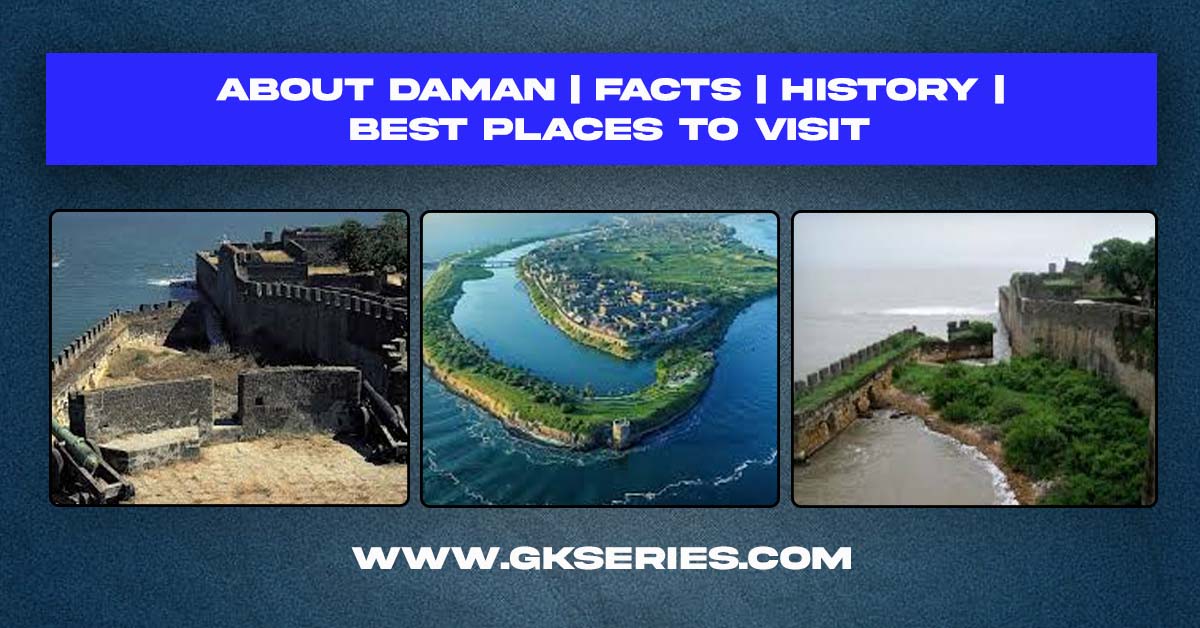
In this article, we provide comprehensive information about the geography, history, population, and top tourist destinations of Daman. Daman and Diu, former union territory of India, which comprised two widely separated districts on the country’s western coast. Daman is an enclave along the southern coast of Gujarat, about 100 miles (160 km) north of Mumbai (formerly known as Bombay). Diu includes an island situated off the southern coast of Gujarat’s Kathiawar Peninsula, approximately 40 miles (64 km) southeast of Veraval, along with a small portion on the mainland. The town of Daman, located in the Daman district, served as the capital of the territory.
| About: | Daman or Damao, a Union Territory was a Portuguese enclave for four centuries and a half till the close of the colonial rule in 1961. The first Portuguese Captain Diogo de Mello, while on his way to Ormuz, met with a violent cyclone and when all hopes were lost, suddenly found himself at the Daman coast. Daman was the battleground to oust the Portuguese and had witnessed many a wars waged against the alien powers. Daman has served as a melting pot where various races and cultures converged, creating a vibrant and diverse identity. This serene haven, known for its peace and tranquility, boasts a coastline of about 12.5 km along the Arabian Sea (the Gulf of Khambhat) and was once referred to as Kalana Pavri, or the Lotus of Marshlands. A relaxed little town, Daman is split by the Damanganga River into Nani Daman (Little Daman) in the north and Moti Daman (Big Daman) in the south, which still retains some of the Portuguese charm in its colonial-era government buildings and churches, all enclosed by a grand wall. Located near Surat in southern Gujarat, Daman is a small port in the Gulf of Khambhat (Cambay). With its convenient access—just 12 km from Vapi, the nearest railway station on the Delhi-Mumbai and Ahmedabad-Mumbai rail routes, and close to the national highway (NH 8)—Daman is not only attracting weekend tourists from nearby Gujarat and Maharashtra but is also set to become a popular destination for travelers from across the country, as well as business visitors. |
| History: | The district of Daman is known to formed part of the country know as Lata which was one of the seven divisions of the Aparant or Konkan Vishaya between 2nd century BC and 13th century AD. The archeological evidences prove that this land formed part of the Mauryan empire at least at the time of Ashoka. After the Mauryan power was weakened, the district was subjected to Satavahana rulers, Satakarni I, in the end of the 2dn century BC. During the first century AD, Kshaharatas seemed to have reigned over Daman district, till 249 AD and then followed by Abhiras who held the sway over entire Daman which lasted till 416 AD. After the rule of Abhir kings, Traikutakas, the feudatories of the Abhiras, seized control of the district during the 5th century AD and their empire extended from Lata country or southern Gujarat to Daman, Konkan and northern Maharashtra. The 500 AD saw the rise in prominence of Vakataka king Harishena, who destroyed the Traikutaka power. Next, the district came under suzerainty of Kalachuris of Mahishamati and Kalachuri reign lasted upto about 609 AD. From the coins found all over this territory, it is learn that the king Mangales of Chalukyas of Badami penetrated to seize control of the Lata country by about 609 AD. The Chalukyas of Badami ruled the district till 671 AD and their descendents known as Lata or Navasari Chalukyas ruled from Navasarika, modern Navasari on the bank of river Purna to the north of Daman. The district passed under the Rashtrakutas of Malkhed from 757-975 AD. They were conquered by Chalukyas of Kalyani in 973 AD. The Chalukya feudatory family named Nimbarka rule covered territory between rivern Tapti and Damanganga. The power of Chalukyas of Kalyani was weakened and the Lata country was annexed to the dominion of Gujarat Chalukyas of Anhilwad in 1160 AD who seem to have ruled over Lata country through their feudatory Simha. He transferred his alliance to Parmar ruler and continued to rule over the Lata Parmar feudatory unti 1217 AD. In about 1187 AD, Yadava sovereignty of Deccan at Devagiri rose in prominence who attacked the Parmar ruler and took control of Lata including Daman by 1223 AD. Yadava Singhana is recognised as the most illustrious ruler of Yadavas of Devagiri dynasty. By the middle of 13th century Rajput Prince, Ramasingh alias Ramasha from Udaipur during the Muslim conquest of Rajasthan came down to seek his fortune in the south seems to have defeated the Koli Chief Nathoart belonging to the Thorat tribe of Kolis and established himself in the hilly treat at Asheri or Asserseta near Daman about 1263 AD. |
| Country : | India |
| Union Territory: | Dadra and Nagar Haveli and Daman and Diu |
| District: | Daman |
| Language: | Hindi, English |
| Population: | 191,173 (2011) |
| Literacy rate: | Literacy rate in Daman and Diu has seen upward trend and is 87.10 percent as per latest population census. |
| Major Attractions to Visit: | Jampore Beach Lighthouse Devka Beach Moti Daman Fort Somnath Mahadev Temple Church Of Our Lady Of Sea Mirasol Lake Garden Cathedral Of Bom Jesus Dominican Monastery St. Jerome Fort |





